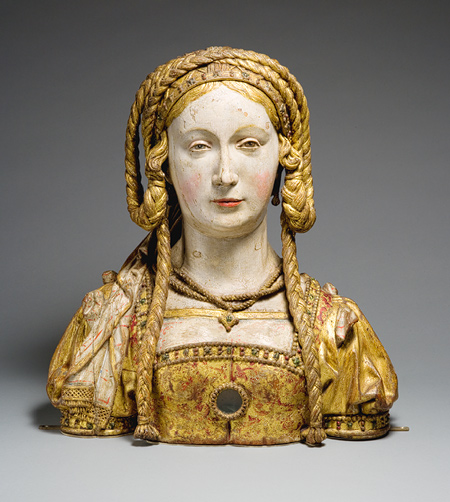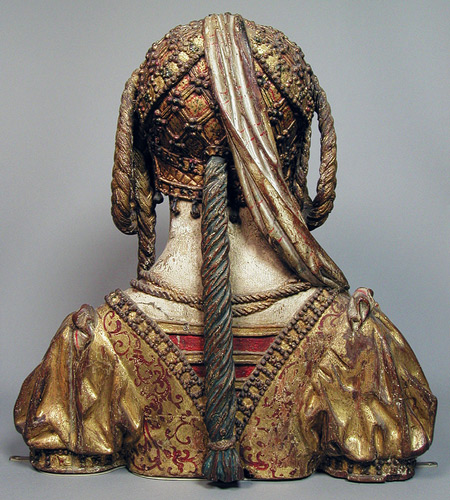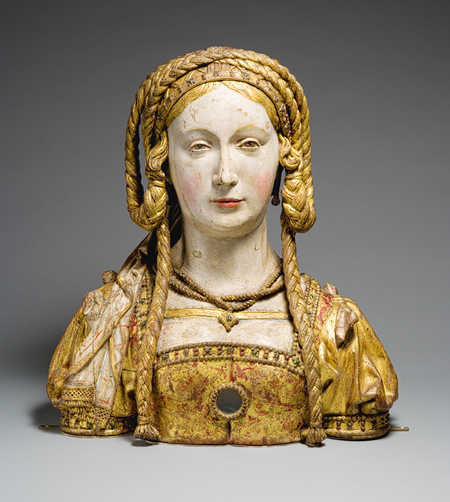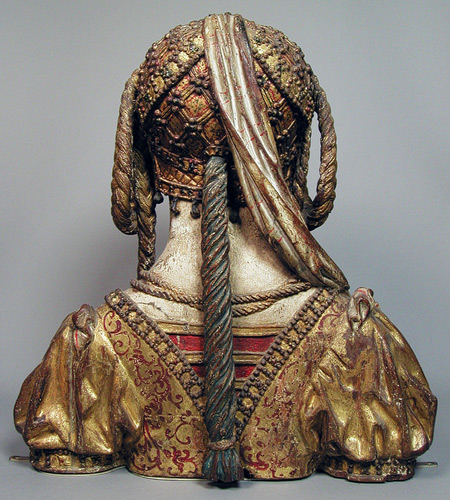Diadem of Princess Khenmet
A gold crown of Princess Khenmet, possibly daughter of King Amenemhat II.
She is mainly known from her unrobbed tomb containing a set of outstanding personal adornments.
This masterpiece was found in the tomb of Khnemet and her sister “Ita” in Dahshur. The crown is made of a network of interlaced gold wires that entangle nearly 200 small flowers, each with a carnelian eye and five turquoise-inlaid petals. The wires are tied to three pins on each side of five ‘crosses’, which are actually five clusters of lotus blossoms, and terminate at a pair of rings on the back of a sixth ‘cross’.
Middle Kingdom, 12th Dynasty, ca. 1991-1803 BC. From Princess Khenmet’s burial next to the pyramid of Amenemhat II at Dahshur. Now in the Egyptian Museum in Cairo.
Tag: history
To call the surrounding marshy spaces ‘liminal’ would be to resort to cliché: fenland is not a limit, not an edge, but a swathe of land that is plural, both land and sea at once, and alternately either; it is a palimpsestic landscape, where one thing overlays another. In the Ango-Saxon mind, this contributed to a very fluid idea of ‘desert’: monks sought isolation, equivalent to that of dry sand-deserts, at the northernmost corner of the Christian world, and found it in the gaping skies and uninhabitable marsh of the fens. St Guthlac set out to test his faith on one such fenland island, and found himself tormented by demons and apparitions. Even in their modern, ordered state, the fens retain an aptitude for soupy fog, illusionistic perspective, and shrieking winds. And they froze in winter, turning an impassible marsh into a frosty, mirror-flat rink. Sharpened animal bones allowed feet and belongings to glide for miles, and so fringe-towns and fen-islands became accessible.
Skater’s Meadow, Robert Hawkins (http://www.theinklingmag.com/fields-buildings/skaters-meadow)
Mughal rock crystal cup inlaid with rubies, emeralds and diamonds, 18th century
via reddit.com
we could’ve just chisled in the fuckin date on it it’s not some stone age creation
yhea because the squid people that inherit the earth will know when Christ was born
They 👏 Will 👏 Be 👏 Catholic
Sacredness is a form of entropy. It accrues to the rational like pollen falling earthward on a spring day or leaves during an autumn chill. The Jacobins and others established their “Cult of Reason,” or their “Cult of the Supreme Being,” re-dedicating churches as temples of reason, and enacting a festival in that ideal’s name upon the altar of Notre Dame. But ultimately temples are places of faith, no matter how loud the denials. A cult is still a cult, after all.
Why the French Revolution’s “Rational” Calendar Wasn’t | JSTOR Daily
via reddit.com
Talk about rolling with it
You ever fuck up so bad you overthrow a Chinese emperor?
I know what the Han Dynasty is, I swear, but I’m so used to seeing Star Wars content on my dash that until I hit “Qin Dynasty” I literally thought this was a Star Wars novel about the one time Han Solo took a job for the Empire and I was thinking 1) this is definitely something Han Solo would do and 2) I need to find the title of that novel so I can read it.
You rarely see a “wend” without a “way.” You can wend your way through a crowd or down a hill, but no one wends to bed or to school. However, there was a time when English speakers would wend to all kinds of places. “Wend” was just another word for “go” in Old English. The past tense of “wend” was “went” and the past tense of “go” was “gaed.” People used both until the 1400s, when “go” became the preferred verb, except in the past tense where “went” hung on, leaving us with an outrageously irregular verb.
4ft 8.5″
Why 4 FEET 8.5 Inches is Very Important
Fascinating Stuff …
Railroad Tracks
The U.S. Standard railroad gauge (distance between the rails) is 4 feet, 8.5 inches.That’s an exceedingly odd number.
Why was that gauge used?
Because that’s the way they built them in England, and English expatriates designed the U.S. Railroads.
Why did the English build them like that?
Because the first rail lines were built by the same people who built the pre-railroad tramways, and that’s the gauge they used.
Why did ‘they’ use that gauge then?
Because the people who built the tramways used the same jigs and tools that they had used for building wagons, which used that wheel spacing.
Why did the wagons have that particular Odd wheel spacing?
Well, if they tried to use any other spacing, the wagon wheels would break on some of the old, long distance roads in England, because that’s the spacing of the wheel ruts.
So, who built those old rutted roads?
Imperial Rome built the first long distance roads in Europe (including England) for their legions. Those roads have been used ever since.
And the ruts in the roads?
Roman war chariots formed the initial ruts, which everyone else had to match for fear
of destroying their wagon wheels.Since the chariots were made for Imperial Rome, they were all alike in the matter of wheel spacing.
Therefore, the United States standard railroad gauge of 4 feet, 8.5 inches is derived from the original specifications for an Imperial Roman war chariot.
In other words, bureaucracies live forever.
So the next time you are handed a specification, procedure, or process, and wonder, ‘What horse’s ass came up with this?’,
you may be exactly right.Imperial Roman army chariots were made just wide enough to accommodate the rear ends of two war horses.
Now, the twist to the story:
When you see a Space Shuttle sitting on its launch pad, you will notice that there are two big booster rockets attached to the sides of the main fuel tank. These are solid rocket boosters, or SRBs.
The SRBs are made by Thiokol at their factory in Utah.
The engineers who designed the SRBs would have preferred to make them a bit larger,
but the SRBs had to be shipped by train from the factory to the launch site.The railroad line from the factory happens to run through a tunnel in the mountains
and the SRBs had to fit through that tunnel.The tunnel is slightly wider than the railroad track, and the railroad track, as you now know,
is about as wide as two horses’ behinds.So, a major Space Shuttle design feature
of what is arguably the world’s most advanced transportation system was determined over two thousand years ago by the width of a horse’s ass.And you thought being a horse’s ass wasn’t important!
Now you know, Horses’ Asses control almost everything.
Explains a whole lot of stuff, doesn’t it?
This is the single most mind blowing fact I’ve read on tumblr, every day is a school day-thank you.
Nice history lesson!
My daughter and I were just discussing this very subject.


Reliquary Bust of Saint Balbina, ca. 1520–30
South Netherlandish (possibly made in Brussels, Belgium)“All reliquaries derive their power from the relic they contain as well as from the beauty and intrinsic qualities of the vessel. Reliquaries in the form of busts became widespread during the High Middle Ages. This head (made of painted and gilded oak) contains the skull of Saint Balbina, an early virgin martyr of Rome. The label on the little door on top identifies the relic inside. She is richly dressed in a fashionable gown and with jewelry and an elaborate coiffure.” (metmuseum.org)


Reliquary Bust of Saint Balbina, ca. 1520–30
South Netherlandish (possibly made in Brussels, Belgium)“All reliquaries derive their power from the relic they contain as well as from the beauty and intrinsic qualities of the vessel. Reliquaries in the form of busts became widespread during the High Middle Ages. This head (made of painted and gilded oak) contains the skull of Saint Balbina, an early virgin martyr of Rome. The label on the little door on top identifies the relic inside. She is richly dressed in a fashionable gown and with jewelry and an elaborate coiffure.” (metmuseum.org)


